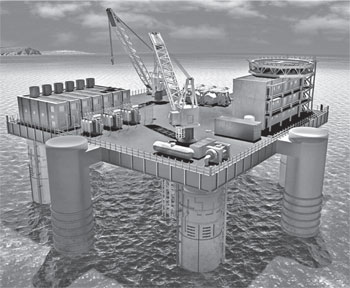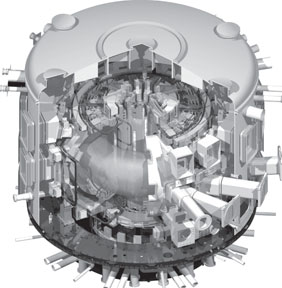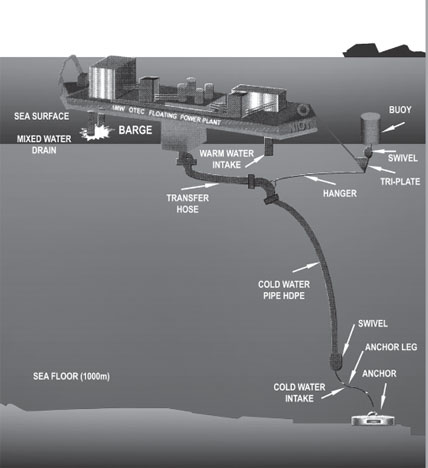|
Several technologies close to commercial reality:
Oceans, a source of limitless energy
By Pramod DE SILVA
The sea is all around us. As islanders, we are familiar with the sea.
It is undoubtedly a very powerful entity - the tsunami proved that. But
what if it can literally give us power - of the kind that keeps our
bulbs lit without a limit? This is not a promise of the future, it is
happening now. Power from the oceans is no longer science fiction, but a
few more decades (and a lot more research) will see better yields and
perfection.
We already derive power from water. This is called hydroelectricity.
Sri Lanka has a number of such plants. But these are freshwater sources.
Although Sri Lanka does not yet have seawater power plants, it could one
day help fulfil the increasing demand for electricity.
|

OTEC offshore platform |
Worldwide, there are a number of plants designed to harness the power
of the sea although the actual implementation of at least one method
could be quite some time away. There are three approaches - thermal
energy, wave energy and the holy grail of power generation, nuclear
fusion, the very same process that is powering the sun for another four
billion years at least. None of the processes is cheap, but once
established through a huge investment, the flow of power is practically
free (and renewable), save for operational costs.
One acronym is already popular - OTEC. It stands for Ocean Thermal
Energy Conversion. This is not even a new idea; the electricity is
generated by exploiting the differences in ocean temperatures. In an
OTEC system, warm water from the ocean surface is used to heat up a
fluid with a low boiling point, such as ammonia. Vapour from the boiling
ammonia turns a turbine that drives a generator to produce electricity.
Deep-sea water is pumped up to cool the ammonia and return it to a
liquid state to be used again.
Floating platform
However, OTEC becomes economically viable only when done on a large
scale on a floating platform anchored offshore. If all goes well, the
first small-scale OTEC plant would be operational soon off the Hawaiian
coast. It is being designed by Makai Ocean Engineering in partnership
with Lockheed Martin Corp., the US Department of Energy and the US Navy.
The final aim of the designers is to build a 100 MW plant before
2018. Scientists say an OTEC plant of at least 100 megawatts could
compete with wind power on a cost basis and of course, the lack of wind
does not affect an OTEC facility.
Thousands of kilometres away in Spain, another ocean energy power
plant has just gone on line. Named Mutriku, it now has a capacity of
only 296 kilowatts, but is likely to expand. The Basque Energy Agency
describes the plant as "the first European plant to supply power using
the waves".
Here, the technology is seemingly simpler and is turbine based, as in
conventional hydro power plants. The technical name for the technology
is Oscillating Water Column (OWC), developed by the Scottish company
Wavegen. Incidentally, Scotland is also trialling a similar system, as
is Portugal. The facility works using the pressure waves exerted on air
columns in the sea wall.
|

ITER Tomakak machine |
The plant has 16 air chambers within the sea wall, so that when waves
arrive, they push up the air in the chambers driving the turbines. When
the waves retreat, the air is sucked out through the turbine, causing
the turbine to turn again, always in the same direction.
The turbines then move a series of generators to produce electricity.
Sea water never comes into contact with the electro-mechanical elements
of the installation, prolonging the life of the plant and reducing
maintenance costs.
Cleaning effect
According to the operators, it will produce an estimated 600,000 kWh
annually, "enough power to supply the needs of 600 people and prevent
the emission of 600 tons of carbon dioxide per annum, equivalent to the
cleaning effect of 80 hectares of forest". The last two statistics are
very revealing - ocean energy can help save the environment in a big
way.
And the cost? It is very competitive, at only 6.7 million euro for
the entire project. Bigger plants will require more money, but the
message is that wave energy is more affordable than we think. Coastal
areas with rough seas, found here in abundance, are ideal for this
system which also promises endless power for a relatively little outlay.
But the next one is easily the biggest. Harnessing nuclear fusion,
the energy that powers the sun, has been an objective of physicists for
many decades. It is essentially inexhaustible and can be created using
hydrogen isotopes extracted from seawater. This is how the sea could
turn out to be our biggest energy source.
Fusion energy is created by fusing two atomic nuclei, in the process
converting mass to energy, which appears as heat. The heat turns water
into steam, which drives turbines to generate electricity. It generates
no greenhouse gases and unlike conventional nuclear fission reactors,
there is no margin for catastrophe.
But let's not get carried away. It is not as easy as it sounds. Among
other challenges, it requires production and confinement of a hot gas, a
plasma, with a temperature around 100 million degrees Celsius.
Magnetic fusion
|

An OTEC system |
But solutions are emerging, according to recent research papers. In
one approach, known as magnetic fusion, hot plasma is confined by
powerful magnets. (Scientists are now able to produce 100 million-degree
plasmas). A second method uses lasers to bombard a frozen pellet of
fusion fuel (deuterium and tritium nuclei) to heat the pellet and cause
fusion to occur in a billionth of a second.
In fact, in just four decades, the power produced by fusion has grown
from one-tenth of a watt, produced for a fraction of a second, to 16
million watts produced for one second - a billion times more.
The European Union, China, India, Japan, Russia, South Korea and the
United States have now joined hands to make fusion power feasible in our
lifetime. The project is known as ITER (International Thermonuclear
Experimental Reactor).
The ITER machine is under construction in St-Paul-lez-Durance, a
commune in the Provence-Alpes-Cote d'Azur region of Southern France that
is already home to France's nuclear research centre and will be
completed in 2019.
Fusion experiments will begin the same year. The scientific goal of
the ITER project is to deliver 10 times the power it consumes. From 50
MW of input power, the ITER machine, known as Tomakak, is designed to
produce 500 MW of fusion power. It will be the first of all fusion
experiments to produce net energy. It will cost billions of dollars to
commercialise fusion power, but mankind will get there.
Fossil fuels are running out. They are finite resources that will one
day be exhausted. The alternative is renewable energy - sources of power
that will not run out and are environment friendly.
Solar, biomass and wind power are making vast strides, while
geothermal power is literally gaining ground. Now we can add ocean power
to this veritable mix. Most people think of the sea as the place where
their fish comes from, but the time has come to change that perception.
After all, less than a couple of decades from now, your house could be
powered by the sea. |

